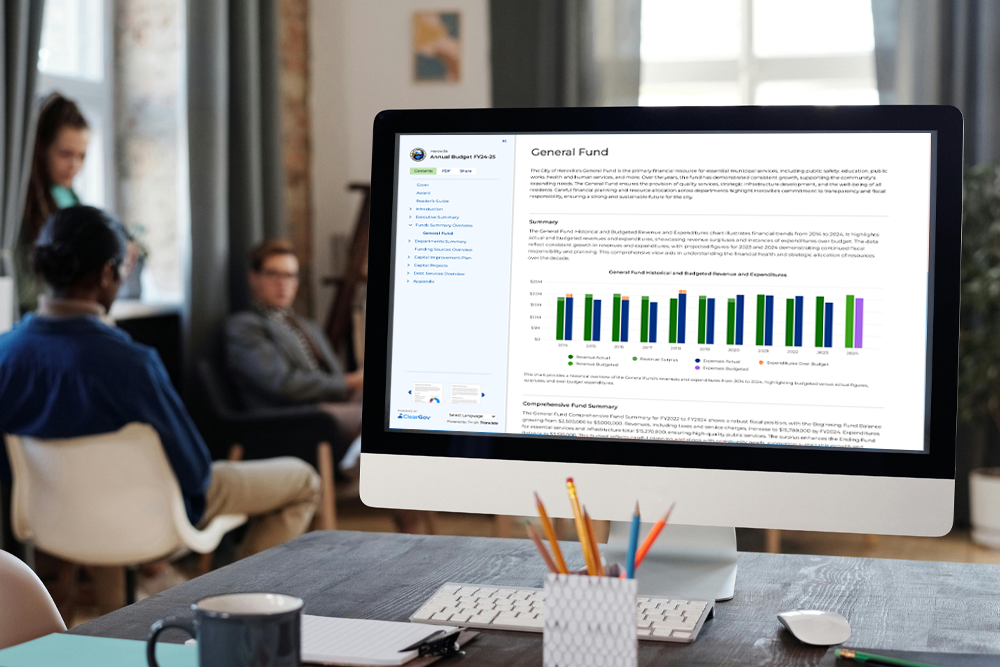Overcoming Financial Reporting’s 5 Biggest Challenges Between time commitments, limited resources, and low comprehension, financial reporting can be tough for public organizations. Find out how to ease the workload in this article. Financial reporting: You know it, you do it, and you love it. Okay, maybe not that last part. Financial reporting is a great opportunity to communicate your organization’s financial story to the general public. It enhances public trust and engagement by giving residents, businesses, and officials financial transparency and accountability. But financial reporting also comes with some key challenges, such as time consumption and low readability. In this article, we’ll discuss those challenges and how your organization can easily overcome them with the right tools. Why is Financial Reporting Important?The Government Finance Officers Association (GFOA) defines four core audiences of financial reporting:
Financial reporting is an essential method for presenting these audiences with key success metrics. Simple financial numbers suffice for private sector companies, since their chief goal is to generate profits and returns for shareholders or investors. For them, financial performance is their ultimate metric of success. A simple balance sheet or an SEC filing does just fine at showcasing these numbers. But local governments and school districts work for the public. And they depend upon assistance from higher-level governments and grantor organizations. So, their performance metrics are more nuanced. They need to show the public and their other financiers not only their financial performance, but what their financial performance is producing for their constituents. This is where financial reporting comes in. By bringing comprehensive financial reporting to the people, organizations can improve their transparency, citizen engagement, and viability for debt funding and grant funding. External Challenges with Financial ReportingFinancial reporting is informative for its intended audiences — but that doesn’t mean the audience members themselves see it that way. Of the biggest challenges facing financial reporting, the first two concern the audiences themselves. Financial Reporting Challenge 1: Low Readability Among AudiencesA comprehensive 2024 GFOA report cited the need to rethink financial reporting based on results from a survey the association commissioned. A key reason for this reevaluation is the survey’s measures of audience interest in the annual comprehensive financial report (ACFR). In the GFOA survey, 95% of elected officials on their governing board indicated interest in seeing if their government received a clean audit. But interest in financial reporting dramatically declined from there. 62% of elected boards were interested in the fund balance, but the majority of surveyed officials were not interested in 10 other elements of financial reporting. The public doesn’t fare any better. 35% of the survey’s respondents said they experienced interest from local organizations like media outlets and watchdog groups. But 60% said that, “the public had ‘little or no interest’ in financial reporting.” Financial Reporting Challenge 2: Stakeholder UnderstandingWhy is there so little interest in financial reporting? Well, for one thing, it’s difficult to understand. Let’s face it: Financial reports aren’t exactly beach reads. They’re usually dense and full of terms that only financial experts understand. Finance teams frequently struggle to make these reports accessible to citizens, elected officials, and other stakeholders who are not financial professionals. More transparency is needed to improve reading comprehension with these reports. Internal Challenges with Financial ReportingEven if audiences are interested in financial reporting, actually carrying it out can be a laborious process. The following challenges concern the public finance officials and professionals who must execute financial reporting. Financial Reporting Challenge 3: Lower Favorability with Public Finance OfficialsAudiences aren’t the only ones with subpar views of financial reporting — some public finance officials share their views. While most GFOA members appreciate financial reporting, the margin is slim. The 2024 GFOA survey found that 55% of respondents saw the benefits of financial reporting outweighing the costs (45% had neutral or unfavorable views of financial reporting). Now, contrast this with GFOA members’ views of budgeting. A previous GFOA survey quoted in the above report found that 77-84% of members were satisfied or very satisfied with budgeting. Clearly, something needs to change for more public finance officials to change their views on financial reporting. Financial Reporting Challenge 4: Immense Time ConsumptionPart of the lower favorability of financial reporting likely concerns the time it takes. Regardless of whether organizations do it fully in-house or with the help of auditors, financial reporting consumes a lot of time — and both methods carry their own sets of unique issues. Conducting financial reporting with auditors involves the following issues:
Conducting financial reporting fully in-house also saddles governments with challenges:
Financial Reporting Challenge 5: Evolving Reporting Standards Facing a Shrinking WorkforceThe extensive time commitment for financial reporting can be tough to shoulder for any organization. But the Governmental Accounting Standards Board (GASB)’s financial reporting standards also shift over time. In 2024 for instance, the GASB issued two new statements that changed their requirements for financial reporting and disclosure of capital assets. These changes will need to be implemented for fiscal years starting after June 15, 2025 — although the GASB encourages organizations to adopt them earlier. Ensuring compliance with the GASB’s evolving standards is a time-consuming task by itself. But public finance teams will need to do it with a shrinking workforce. A GFOA and Lightcast report shows that demand for public finance officers exceeds the supply of professionals in the field. So, organizations that are implementing the GASB’s 2024 changes may have less financial professionals to take that work on. Rewriting the Financial Reporting NarrativeMinimal appeal to audiences. Low comprehension. Middling financial official interest. Massive time consumption. Growing requirements for a workforce that’s stretched thin. The hurdles against financial reporting might seem stacked against it. But they don’t have to be, and your organization can rewrite the financial reporting narrative. The answer lies in using an innovative web-based tool to improve the process and provide a digital window into your organization’s performance. ClearGov: Your Partner in Improving and Streamlining Financial ReportingClearGov’s new Digital Financial Reporting solution is a comprehensive tool that is designed to streamline and enhance financial reporting. It enables users to generate and publish essential financial documents in both PDF and web formats, offering a modern, accessible way to share reports with stakeholders. Digital Financial Reporting combines advanced text editing, interactive charting, and fully integrated financial statements, allowing for clear, insightful presentations of financial data. Our solution provides a versatile, user-friendly solution that supports detailed, accurate, and visually engaging financial reporting. And it addresses each of the five aforementioned financial reporting challenges head-on. Digital Financial Reporting Improves Stakeholder Accessibility and ComprehensionClearly, financial reports must be made more accessible — to the public and elected officials alike. ClearGov’s Digital Financial Reporting transforms static PDF reports into interactive, web-friendly documents that are easier to navigate. Stakeholders can click through sections, view dynamic charts, and access the information they need without wading through hundreds of pages of technical data. Ensuring digital accessibility is also becoming increasingly important, especially with the expansion of ADA (Americans with Disabilities Act) guidelines. Digital Financial Reporting creates web-based ADA-compliant reports, which ensures that everyone—including those with disabilities—can access and understand your organization’s financial reports. Digital Financial Reporting Saves Finance Teams TimeCollaboration and Real-Time Review ClearGov’s Digital Financial Reporting saves public finance teams their most valuable commodity: time. Digital Financial Reporting does this in several ways: Many governments find it challenging to collaborate effectively on financial reports, especially when multiple departments need to contribute or review sections of the report. Digital Financial Reporting allows you to invite colleagues and control access to editing and/or reviewing each page. The solution’s central portal also empowers your team and auditor to work together efficiently, eliminating endless email chains. Error Reduction Digital Financial Reporting enables you to dynamically update financial data, seamlessly reflecting changes across statements, charts, and narratives throughout your report. This significantly reduces errors. After the initial setup in year one, you can automate your financial statements, giving you more time to concentrate on crafting your narrative. Pre-Built Templates and Financial Statement Builder Digital Financial Reporting offers pre-built templates that are specifically designed for financial reporting. These templates automatically adhere to the GASB’s formatting and content standards, and they reduce the time spent on design and ensuring compliance. Financial statement builders allow you to pull in data dynamically, so when figures change, the reports update automatically. This saves a significant amount of time compared to manually updating every line item. Digital Financial Reporting Meets Evolving GASB Standards and GFOA COA Award GuidelinesDigital Financial Reporting automatically updates templates and workflows to ensure that your reports meet the latest GASB requirements. This means your team can focus more on analysis and narrative, rather than worrying about whether the latest standards have been properly applied. For many finance departments, receiving the GFOA’s Certificate of Achievement for Excellence in Financial Reporting (COA) is a significant accomplishment. Digital Financial Reporting makes it easier to meet the GFOA’s stringent COA requirements, ensuring that your financial reports are not only compliant but also standout examples of high-quality financial reporting. Streamline and Upgrade Your Financial Reporting Today with ClearGov’s Digital Financial ReportingOur team of public finance experts is here to help you overcome your financial reporting challenges. With ClearGov’s new Digital Financial Reporting solution, your organization can create web-based financial reports that are efficient, accessible, compliant, and award-ready. Request a demo today and see how ClearGov can transform your organization’s financial reporting. |












